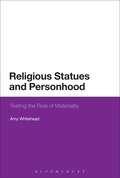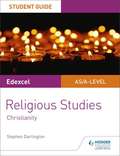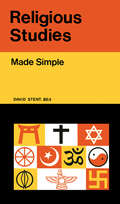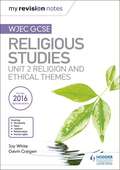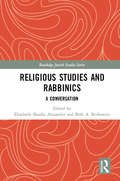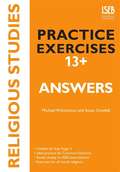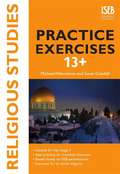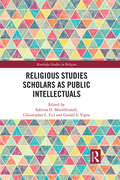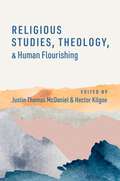- Table View
- List View
Religious Statues and Personhood: Testing the Role of Materiality
by Amy WhiteheadObjects such as statues and icons have long been problematic in the study of religion, especially in European Christianities. Through examining two groups, the contemporary Pagan Glastonbury Goddess religion in the Southwest of England and a cult of the Virgin Mary in Andalusia, Spain, Amy Whitehead asserts that objects can be more than representational or symbolic. In the context of increasing academic interest in materiality in religions and cultures, she shows how statues, or 'things', are not always interacted with as if they are inert material against which we typically define ourselves as 'modern' humans.Bringing two distinct cultures and religions into tension, animism and 'the fetish' are used as ways in which to think about how humans interact with religious statues in Western Europe and beyond. Both theoretical and descriptive, the book illustrates how religions and cultural practices can be re-examined as performances that necessarily involve not only human persons, but also objects.
Religious Statues and Personhood: Testing the Role of Materiality
by Amy WhiteheadObjects such as statues and icons have long been problematic in the study of religion, especially in European Christianities. Through examining two groups, the contemporary Pagan Glastonbury Goddess religion in the Southwest of England and a cult of the Virgin Mary in Andalusia, Spain, Amy Whitehead asserts that objects can be more than representational or symbolic. In the context of increasing academic interest in materiality in religions and cultures, she shows how statues, or 'things', are not always interacted with as if they are inert material against which we typically define ourselves as 'modern' humans.Bringing two distinct cultures and religions into tension, animism and 'the fetish' are used as ways in which to think about how humans interact with religious statues in Western Europe and beyond. Both theoretical and descriptive, the book illustrates how religions and cultural practices can be re-examined as performances that necessarily involve not only human persons, but also objects.
Religious Stereotyping and Interreligious Relations
by Jesper Svartvik Jakob WirénThis collection of essays by array of international scholars addresses some aspects of the issues of religious stereotyping, prejudice and discrimination and offers solutions through discussions of method, terminology and definitions regarding interreligious relations, the political implications in the Middle East, and various case-studies.
Religious Studies: A Global View
by Gregory D. AllesDrawing on recent developments in the comparative study of religion, this book explores the trends of the past sixty years from a global perspective. Each of the ten chapters covers the study of religion in a different region of the world, from Europe and the Americas to Asia and the Far East. Topics covered include: local background to the study of religions formation of religious studies in the region important thinkers and writings institutions interregional diversity and interregional connections emerging issues. This book is a major contribution to the field of religious studies and a valuable reference for scholars, researchers and graduate students.
Religious Studies: A Global View
by Gregory D. AllesDrawing on recent developments in the comparative study of religion, this book explores the trends of the past sixty years from a global perspective. Each of the ten chapters covers the study of religion in a different region of the world, from Europe and the Americas to Asia and the Far East. Topics covered include: local background to the study of religions formation of religious studies in the region important thinkers and writings institutions interregional diversity and interregional connections emerging issues. This book is a major contribution to the field of religious studies and a valuable reference for scholars, researchers and graduate students.
Religious Studies: Christianity (PDF)
by Stephen DarlingtonExam board: Edexcel Level: A-level Subject: Religious Studies First teaching: September 2016 First exams: Summer 2017 Build, reinforce and assess students' knowledge throughout their course; tailored to the 2016 Edexcel A level specification and brought to you by the leading Religious Studies publisher, this guide combines clear content coverage with practice questions and sample answers. Written by teachers with extensive examining experience, this guide: - Helps students identify what they need to know with a concise summary of the topics examined at AS and A-level - Consolidates understanding through assessment tips - Offers opportunities for students to improve their exam technique by consulting sample student answers and commentary for each question type - Builds understanding through accessible explanations of key definitions and thinkers
Religious Studies: Philosophy Of Religion (PDF)
by Amanda Forshaw Cressida TweedExam board: Edexcel Level: A-level Subject: Religious Studies First teaching: September 2016 First exams: Summer 2017 Build, reinforce and assess students' knowledge throughout their course; tailored to the 2016 Edexcel A level specification and brought to you by the leading Religious Studies publisher, this guide combines clear content coverage with practice questions and sample answers. Written by teachers with extensive examining experience, this guide: - Helps students identify what they need to know with a concise summary of the topics examined at AS and A-level - Consolidates understanding through assessment tips - Offers opportunities for students to improve their exam technique by consulting sample student answers and commentary for each question type - Builds understanding through accessible explanations of key definitions and thinkers
Religious Studies: Paper 1 Philosophy Of Religion And Ethics (PDF)
by Kim HandsTarget success in AQA A-level Religious Studies with this proven formula for effective, structured revision; key content coverage is combined with exam-style tasks and practical tips to create a revision guide you can rely on to review, strengthen and test their knowledge. With My Revision Notes you can: - Plan and manage a successful revision programme using the topic-by-topic planner - Consolidate subject knowledge by working through clear and focused content coverage - Test understanding and identify areas for improvement with regular 'Now Test Yourself' tasks and answers - Improve exam technique through practice questions, expert tips and examples of typical mistakes to avoid
Religious Studies: Made Simple
by David StentReligious Studies: Made Simple presents an extensive examination of the religious beliefs and rituals. It discusses the principles behind the historical origin of Judaism. It addresses studies in the beliefs, teachings, and practices of Jewish beliefs. Some of the topics covered in the book are the examination of biblical evidence of Christianity; development of the Christian faith; developments within the Church in England; existence and nature of God; private and social aspects of religion; pre-Islamic religion in Arabia; and the use of language in religion. The definition and description of morality, death, and immortality are fully covered. An in-depth account of the common features of Islamic beliefs social customs, and practices are provided. The influence of Islam is completely presented. A chapter is devoted to description and traditions of Hinduism. Another section focuses on the religious practices of the Sikh. The book can provide useful information to sociologists, philosophers, students, and researchers.
Religious Studies: Unit 2 - Religion and Ethical Themes (PDF) (My Revision Notes WJEC GCSE)
by Joy White Gavin CraigenTarget success in WJEC GCSE Religious Studies with this proven formula for effective, structured revision; key content coverage is combined with exam-style tasks and practical tips to create a revision guide you can rely on to review, strengthen and test their knowledge. With My Revision Notes you can: - Plan and manage a successful revision programme using the topic-bytopic planner. - Consolidate subject knowledge by working through clear and focused content coverage. - Test understanding and identify areas for improvement with regular 'Now Test Yourself' tasks and answers. - Improve exam technique through practice questions, expert advice and examples of typical mistakes to avoid.
Religious Studies and Rabbinics: A Conversation (Routledge Jewish Studies Series)
by Beth A. Berkowitz Elizabeth Shanks AlexanderReligious Studies and Rabbinics have overlapping yet distinct interests, subject matter, and methods. Religious Studies is committed to the study of religion writ large. It develops theories and methods intended to apply across religious traditions. Rabbinics, by contrast, is dedicated to a defined set of texts produced by the rabbinic movement of late antiquity. Religious Studies and Rabbinics represents the first sustained effort to create a conversation between these two academic fields. In one trajectory of argument, the book shows what is gained when each field sees how the other engages the same questions: When did the concept of "religion" arise? How should a scholar’s normative commitments interact with their scholarship? The book argues that if scholars from Religious Studies and Rabbinics do not realize they are addressing the same problems, they will not benefit from each other’s solutions. A second line of argument brings research methods, theoretical claims, and data associated with one field into contact with those of the other. When Religious Studies categories such as "ritual" or "the sacred" are applied to data from Rabbinics and, conversely, when text-reading strategies distinctive to Rabbinics are employed for texts from other traditions, both Religious Studies and Rabbinics enlarge their scope. The chapters range across such themes as ritual failure; rabbinic conceptions of scripture, ethics, food, time, and everyday life; problems of definition and normativity in the study of religion; J.Z. Smith’s writings; and the preaching of the African-American Christian evangelical social justice activist John Perkins. With chapters written by world-class theorists of Religious Studies and prominent text scholars of Rabbinics, the book provides a unique opportunity to expand the conceptual reach and scholarly audience of both Religious Studies and Jewish Studies.
Religious Studies and Rabbinics: A Conversation (Routledge Jewish Studies Series)
by Beth A. Berkowitz Elizabeth Shanks AlexanderReligious Studies and Rabbinics have overlapping yet distinct interests, subject matter, and methods. Religious Studies is committed to the study of religion writ large. It develops theories and methods intended to apply across religious traditions. Rabbinics, by contrast, is dedicated to a defined set of texts produced by the rabbinic movement of late antiquity. Religious Studies and Rabbinics represents the first sustained effort to create a conversation between these two academic fields. In one trajectory of argument, the book shows what is gained when each field sees how the other engages the same questions: When did the concept of "religion" arise? How should a scholar’s normative commitments interact with their scholarship? The book argues that if scholars from Religious Studies and Rabbinics do not realize they are addressing the same problems, they will not benefit from each other’s solutions. A second line of argument brings research methods, theoretical claims, and data associated with one field into contact with those of the other. When Religious Studies categories such as "ritual" or "the sacred" are applied to data from Rabbinics and, conversely, when text-reading strategies distinctive to Rabbinics are employed for texts from other traditions, both Religious Studies and Rabbinics enlarge their scope. The chapters range across such themes as ritual failure; rabbinic conceptions of scripture, ethics, food, time, and everyday life; problems of definition and normativity in the study of religion; J.Z. Smith’s writings; and the preaching of the African-American Christian evangelical social justice activist John Perkins. With chapters written by world-class theorists of Religious Studies and prominent text scholars of Rabbinics, the book provides a unique opportunity to expand the conceptual reach and scholarly audience of both Religious Studies and Jewish Studies.
Religious Studies and the Goal of Interdisciplinarity (Routledge Focus on Religion)
by Brent SmithThis book offers a survey of the development of interdisciplinarity in religious studies within academia and offers ways for it to continue to progress in contemporary universities. It examines the use of the term ‘interdisciplinary’ in the context of the academic study of religion and how it shapes the way scholarly work in this field has developed. The text uses two main elements to discuss religious studies as a field. Firstly, it looks at the history of the development of religious studies in academia, as seen through an interdisciplinary critique of the university as an epistemological project. It then uses the same interdisciplinary critique to develop a foundation for a 21st-century hermeneutic, one which uses the classical concepts reprised by that interdisciplinary critique and retools the field for the 21st century. Setting out both the objects of religious studies as a subject and the techniques used to employ the study of those objects, this book offers an invaluable perspective on the progress of the field. It will, therefore, be of great use to scholars of research methods within religious studies.
Religious Studies and the Goal of Interdisciplinarity (Routledge Focus on Religion)
by Brent SmithThis book offers a survey of the development of interdisciplinarity in religious studies within academia and offers ways for it to continue to progress in contemporary universities. It examines the use of the term ‘interdisciplinary’ in the context of the academic study of religion and how it shapes the way scholarly work in this field has developed. The text uses two main elements to discuss religious studies as a field. Firstly, it looks at the history of the development of religious studies in academia, as seen through an interdisciplinary critique of the university as an epistemological project. It then uses the same interdisciplinary critique to develop a foundation for a 21st-century hermeneutic, one which uses the classical concepts reprised by that interdisciplinary critique and retools the field for the 21st century. Setting out both the objects of religious studies as a subject and the techniques used to employ the study of those objects, this book offers an invaluable perspective on the progress of the field. It will, therefore, be of great use to scholars of research methods within religious studies.
Religious Studies for Common Entrance 13+ Revision Guide (2nd edition) (PDF)
by Michael WilcocksonThis edition of the Religious Studies for Common Entrance 13+ Revision Guide provides a summary of all prescribed Old and New Testament texts, together with a comprehensive analysis of the issues raised by each as well as a section focusing on Contemporary Issues. An additional revision section covers the history, structure and key beliefs of the six major world religions: Christianity, Judaism, Islam, Hinduism, Buddhism and Sikhism. Pupils can perfect their exam technique using sample exam questions included in the book, and a comprehensive glossary defines all the key terms required at this level. - Endorsed by ISEB - Consolidates the key facts that pupils need to know for Syllabus A of the Common Entrance exam - Clear, bullet-point format for ease of learning - Sample exam questions test understanding and help identify strengths and weaknesses - Comprehensive glossary for quick and easy reference/
Religious Studies Practice Exercises 13+: Answer Book (PDF)
by Michael Wilcockson Susan GrenfellContains a full set of answers to the exercises in Religious Studies Practice Exercises 13+. This title includes a comprehensive range of Common Entrance exam-style questions for pupils working towards syllabus A of the new 2011 examination. It is suitable for pupils working towards Common Entrance or entrance exams at 13+.
Religious Studies Practice Exercises 13+ (PDF)
by Susan GrenfellProvides a comprehensive range of exam-style questions based on syllabus A of the 2011 Religious Studies Common Entrance exam. The guide is laid out to correspond with the examination paper and includes sections on Biblical Stories, World Religions and Contemporary Issues, allowing pupils to familiarise themselves with the format of the exam.
Religious Studies Scholars as Public Intellectuals (Routledge Studies in Religion)
by Sabrina D. MisirHiralall Christopher L. Fici Gerald S. VignaThe prominence of religion in recent debates around politics, identity formation, and international terrorism has led to an increased demand on those studying religion to help clarify and contextualise religious belief and practice in the public sphere. While many texts focus on the theoretical development of the subject, this book outlines a wider application of these studies by exploring the role of religious studies scholars and theologians as public intellectuals. This collection of essays first seeks to define exactly what makes an intellectual "public". It then goes on to deal with a few questions of concern: How do public intellectuals construct knowledge in religious and theological scholarship? What is the link between public intellectuals of higher education and their role in society? Do higher education institutions have a responsibility to endorse public intellectualism? Looking at the individual and collective role of religious studies scholars and theologians in public life, this book will be of great interest to all scholars and academics involved in religious studies and theology across the academy.
Religious Studies Scholars as Public Intellectuals (Routledge Studies in Religion)
by Sabrina D. MisirHiralall Christopher L. Fici Gerald S. VignaThe prominence of religion in recent debates around politics, identity formation, and international terrorism has led to an increased demand on those studying religion to help clarify and contextualise religious belief and practice in the public sphere. While many texts focus on the theoretical development of the subject, this book outlines a wider application of these studies by exploring the role of religious studies scholars and theologians as public intellectuals. This collection of essays first seeks to define exactly what makes an intellectual "public". It then goes on to deal with a few questions of concern: How do public intellectuals construct knowledge in religious and theological scholarship? What is the link between public intellectuals of higher education and their role in society? Do higher education institutions have a responsibility to endorse public intellectualism? Looking at the individual and collective role of religious studies scholars and theologians in public life, this book will be of great interest to all scholars and academics involved in religious studies and theology across the academy.
Religious Studies Skills Book: Close Reading, Critical Thinking, and Comparison
by Eugene V. Gallagher Joanne MaguireStudying religion in college or university? This book shows you how to perform well on your course tests and examinations, write successful papers, and participate meaningfully in class discussions. You'll learn new skills and also enhance existing ones, which you can put into practice with in-text exercises and assignments. Written by two award-winning instructors, this book identifies the close reading of texts, material culture, and religious actions as the fundamental skill for the study of religion at undergraduate level. It shows how critical analytical thinking about religious actions and ideas is founded on careful, patient, yet creative “reading” of religious stories, rituals, objects, and spaces. The book leads you through the description, analysis, and interpretation of examples from multiple historical periods, cultures, and religious traditions, including primary source material such as Matthew 6:9-13 (the Lord's Prayer), the gohonzon scroll of the Japanese new religion Soka Gakkai, and the pilgrimage to Mecca (hajj). It provides you with typical assignments you will encounter in your studies, showing you how you might approach tasks such as reflective, interpretive or summary essays. Further resources, found on the book's website, include bibliographies, and links to useful podcasts.
Religious Studies Skills Book: Close Reading, Critical Thinking, and Comparison
by Eugene V. Gallagher Joanne MaguireStudying religion in college or university? This book shows you how to perform well on your course tests and examinations, write successful papers, and participate meaningfully in class discussions. You'll learn new skills and also enhance existing ones, which you can put into practice with in-text exercises and assignments. Written by two award-winning instructors, this book identifies the close reading of texts, material culture, and religious actions as the fundamental skill for the study of religion at undergraduate level. It shows how critical analytical thinking about religious actions and ideas is founded on careful, patient, yet creative “reading” of religious stories, rituals, objects, and spaces. The book leads you through the description, analysis, and interpretation of examples from multiple historical periods, cultures, and religious traditions, including primary source material such as Matthew 6:9-13 (the Lord's Prayer), the gohonzon scroll of the Japanese new religion Soka Gakkai, and the pilgrimage to Mecca (hajj). It provides you with typical assignments you will encounter in your studies, showing you how you might approach tasks such as reflective, interpretive or summary essays. Further resources, found on the book's website, include bibliographies, and links to useful podcasts.
Religious Studies, Theology, and Human Flourishing (The Humanities and Human Flourishing)
by Justin Thomas Mcdaniel and Hector KilgoeReligious Studies, Theology, and Human Flourishing explores the implications of religious studies and theology for well-being, illuminating connections between theory, pedagogy, and practice with nuance and depth. Contributors to the volume, part of The Humanities and Human Flourishing series, construct and critique various conceptualizations of well-being and different approaches to its cultivation, both inside and outside of the classroom. From north India to the buckle of the American Bible Belt, the volume provides a variety of perspectives on approaches to the cultivation of well-being, including formations of the ideal life and the perfect death in antiquity and modernity in the Muslim world; constructions of existential meaning, purpose, and goodness in pastoral theology, care, and counseling; and skepticism surrounding understandings of religion and spirituality in positive psychology, among others.
Religious Studies, Theology, and Human Flourishing (The Humanities and Human Flourishing)
Religious Studies, Theology, and Human Flourishing explores the implications of religious studies and theology for well-being, illuminating connections between theory, pedagogy, and practice with nuance and depth. Contributors to the volume, part of The Humanities and Human Flourishing series, construct and critique various conceptualizations of well-being and different approaches to its cultivation, both inside and outside of the classroom. From north India to the buckle of the American Bible Belt, the volume provides a variety of perspectives on approaches to the cultivation of well-being, including formations of the ideal life and the perfect death in antiquity and modernity in the Muslim world; constructions of existential meaning, purpose, and goodness in pastoral theology, care, and counseling; and skepticism surrounding understandings of religion and spirituality in positive psychology, among others.
Religious symbols - 1 (Large Print)
by Rnib BookshareThere are five religious symbol images on this page. There is a locator dot shown, which will be at the top left when the images are the correct way up. In the top left is a Christian cross and the fish symbol. In the top right is the Orthodox Patriarchal cross with two horizontal bars. In the bottom left is the six-pointed Star of David made of six triangles surrounding a hexagon. In the bottom right is the Pagan Solar cross symbol with a vertical and a horizontal line within a circle.
Religious symbols - 1 (UEB Contracted)
by Rnib BookshareThere are five religious symbol images on this page. There is a locator dot shown, which will be at the top left when the images are the correct way up. In the top left is a Christian cross and the fish symbol. In the top right is the Orthodox Patriarchal cross with two horizontal bars. In the bottom left is the six-pointed Star of David made of six triangles surrounding a hexagon. In the bottom right is the Pagan Solar cross symbol with a vertical and a horizontal line within a circle.
